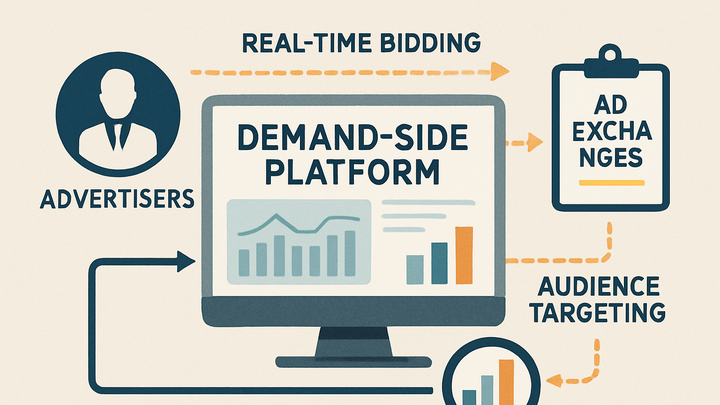Published on 2025-06-28T03:47:46Z
What is a Demand-Side Platform (DSP)? Examples and Analytics Integration
Demand-Side Platform (DSP) is a software system that enables advertisers to buy and manage digital ad inventory programmatically across multiple ad exchanges and supply sources. It automates the process of bidding on ad placements in real-time auctions, allowing advertisers to target audiences with precision based on demographics, behavior, and contextual signals. DSPs integrate with data management platforms (DMPs) and analytics tools to inform bidding decisions and optimize campaigns for performance metrics such as conversions, ROI, and viewability. They offer scalable media buying, centralized campaign management, and advanced reporting capabilities. By leveraging machine learning and real-time data, DSPs continuously refine targeting strategies, budget allocation, and bid prices to maximize campaign effectiveness within defined budgets. Integration with analytics solutions like Google Analytics 4 (GA4) and privacy-focused tools like PlainSignal ensures comprehensive performance tracking and compliance with data regulations.
Demand-side platform
A Demand-Side Platform automates media buying in real time, enabling advertisers to target audiences programmatically and optimize campaigns efficiently.
Overview of Demand-Side Platforms
This section introduces the core concept of Demand-Side Platforms, their primary functions, and their role in the broader programmatic advertising ecosystem.
-
Definition of dsp
A DSP is a centralized software solution that allows advertisers to purchase ad impressions across multiple exchanges and publishers via automated, real-time bidding.
-
Core components
DSPs consist of modular systems that handle bidding logic, data management, and performance reporting to facilitate efficient ad buying.
-
Bidder engine
Processes bid requests and submits bids to ad exchanges in real time.
-
Data management module
Aggregates, segments, and activates audience data for precise targeting.
-
Analytics & reporting
Provides dashboards and reports to track campaign performance and ROI.
-
-
Role in programmatic advertising
DSPs connect advertisers with supply-side platforms and ad exchanges, streamlining the purchase of ad inventory through automated auctions.
How DSPs Work
Explore the technical workflow of DSPs, from receiving bid requests to optimizing campaigns using data-driven algorithms.
-
Bid request processing
Upon receiving a bid request, the DSP evaluates the opportunity against campaign criteria and budget constraints.
-
Audience targeting
DSPs use audience data to match ad impressions to the most relevant users, improving engagement and ROI.
-
First-party data
Data collected directly by the advertiser, such as CRM records and on-site behavior.
-
Third-party data
External audience segments purchased from data providers to enrich targeting.
-
-
Optimization algorithms
Machine learning models adjust bid prices, budget allocation, and targeting parameters to maximize campaign goals.
Key Benefits and Use Cases
Highlight the main advantages of using DSPs and common scenarios where they deliver significant value.
-
Efficiency and scale
Automates the ad buying process, enabling campaigns to run across thousands of publishers without manual intervention.
-
Improved targeting and personalization
Leverages data for granular audience segmentation and delivers personalized ad experiences.
-
Data-driven insights
Provides real-time reporting and analytics to measure performance and inform strategic adjustments.
-
Real-time metrics
Monitors impressions, clicks, and conversions live to enable agile decision-making.
-
Attribution modeling
Analyzes conversion paths to accurately attribute impact across channels.
-
Integrating Analytics with DSPs
Discusses how to track and measure DSP-driven campaigns using both cookie-free and traditional analytics platforms.
-
Using PlainSignal for cookie-free tracking
Leverage PlainSignal’s privacy-first analytics to capture DSP landing page metrics without relying on cookies.
-
Setup data attributes
Add
data-doanddata-idattributes to your HTML tags to identify and track page views. -
Privacy compliance
Ensure GDPR and CCPA compliance through PlainSignal’s cookie-free and user-friendly approach.
-
-
Implementing GA4 with dsp campaigns
Integrate Google Analytics 4 to monitor ad performance, user engagement, and conversion events from DSP traffic.
-
Utm parameters
Append UTM tags to ad URLs to distinguish traffic sources and campaign names.
-
Event tracking
Configure GA4 events to capture key user actions driven by DSP ads.
-
Conversion goals
Define goals in GA4 to measure campaign success, such as form submissions or purchases.
-
-
Example tracking code
Displays the PlainSignal integration snippet for cookie-free tracking of DSP campaign performance.
-
Integration snippet
<link rel="preconnect" href="//eu.plainsignal.com/" crossorigin /><script defer data-do="yourwebsitedomain.com" data-id="0GQV1xmtzQQ" data-api="//eu.plainsignal.com" src="//cdn.plainsignal.com/plainsignal-min.js"></script>
-
